A BATHTIME JIGSAW PUZZLE
The big renovation project for the winter of 2015/16 is the ground floor bathroom and in this update, I will be describing the first part of that undertaking. The bathroom was made some years ago out of a hallway which led to the back door. It is long, but narrow and we wanted to move the toilet onto the long wall without sitting staring at the opposite wall just in front of our faces. So a couple of years ago I knocked out part of one long wall and moved it back some half a metre.
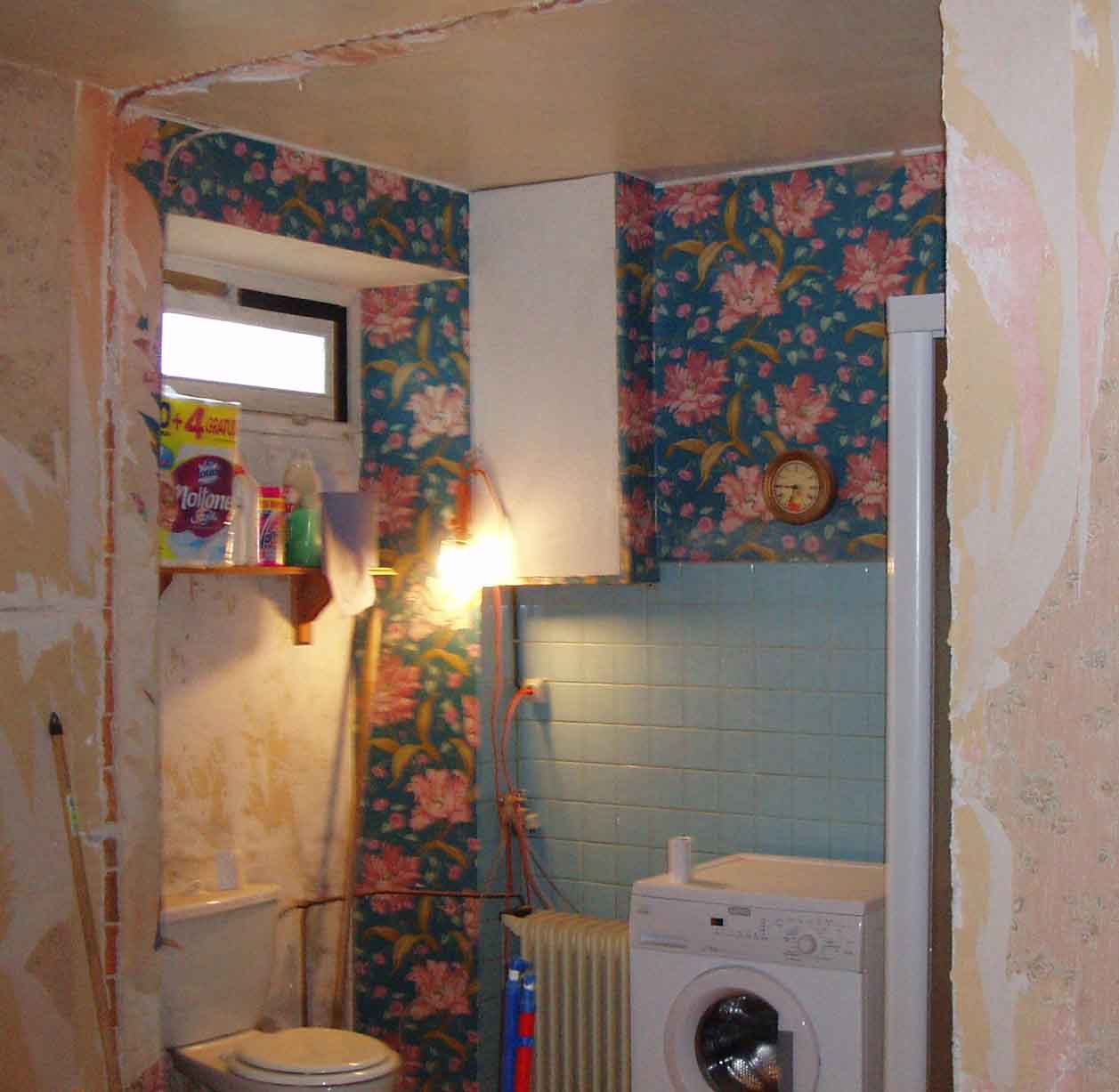
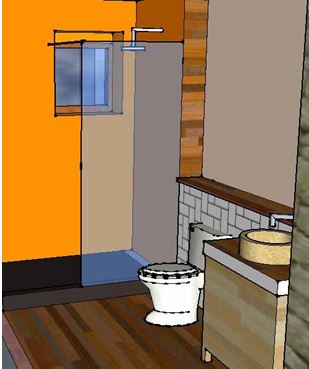
On the left is the bathroom in the state it was in just after I knocked part of the wall down. You have to admit, the wallpaper is something else. Next to it is a sketch of what it will hopefully look like at the end. After the W.C. moves onto the long wall, where the toilet is now will be blocked in and a wet room style shower (called an Italian shower in France) will stretch right across the room; just in case the local rugby team all need to shower at the same time.

This is our only bathroom at the moment and a complete reconstruction requires some very careful planning to avoid losing use of it for more than a couple of hours at a time.
The current toilet, shower and wash basin all have water feeds in and drainage out and these need to be left in place until we are ready to switch to the new appliances, which are all in different places to the current set. There are a couple of things that make this possible. Firstly, last year I had had new hot and cold 22mm water feeds laid to the bathroom and terminated by a manifold (a collecteur in French) with four hot and four cold 15mm outlets.
The French use these manifolds a lot and they do make it very easy to isolate individual appliances without turning off the water supply.
Secondly, we were building an inner wall for insulation purposes half way up the existing wall and that means that we can leave some of the old drainage sealed up behind it if necessary.
However it does mean that there is a strict order of work:
1) Install new toilet.
2) Take out old toilet.
3) Build walls and install new window.
4) Install new shower.
5) Dismantle old shower.
6) Lay flooring.
7) Install new basin.
8) Dismantle old basin.
9) Build towel cupboard.
Simple n'est pas. Well no, not actually. For instance, the drainage for the new basin needs to be in place before the toilet is installed, because we won't be able to work on part of it once the wall blocks are in place. Likewise, we need to lay part of the flooring in order to stand the toilet bowl on it, but only a small part.
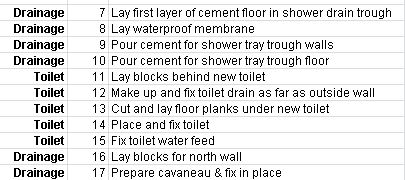
Many hours were spent poring over the plans and an Excel spreadsheet laying out the list of jobs. Excel is excellent (Ok, bad pun) for this sort of thing because of the ability to sort a block of data by the value of a particular column.
Sorting by the first column allows me to easily check that I haven't missed out a task and sorting by the second column gives me the overall order of the tasks. To add a task or change the order, I simply renumber and resort.

For instance, here I need a drainage task between 14 and 15 to connect the new toilet drain to the septic tank. Add it after task 17, renumber 15 through 17 and resort.
Bingo. Tis done.
It turned out that the first task (the corner piece of the jigsaw if you will) was to dig out the floor and drill through the outside wall for the shower drain. This is because, whilst the toilet drain will be installed first, the shower drain runs underneath it.
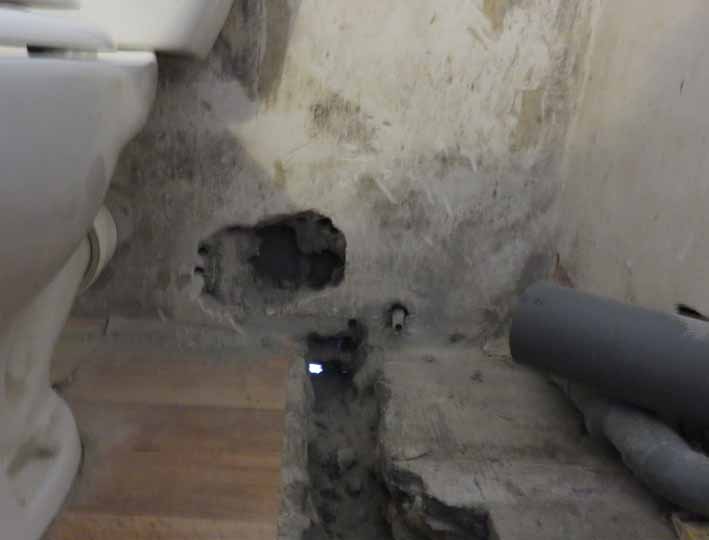
On the right of the picture is the new toilet drain, sitting on top of the existing shower drain. The toilet drain will go through the large hole and replace the existing toilet drain somewhere outside the house. This particular bit of wall is concrete block, so making the large hole is simple, but the channel in the floor for the shower drain leads straight to a solid granite beam that used to be the old doorstep. It has taken two days to get through that, alternatively drilling and chiseling. The white spot on the left of the hole is daylight shining through the original pilot hole.
Before you start boring through granite you need some good quality masonry bits. Most masonry bits have two cutting edges, called flutes, but to get through granite you need four, otherwise the bit will wander all over the place. The technique I use is to first drill a small hole about 10mm deep and some 8mm in diameter, which then acts as a guide for the much larger 25mm diameter drill bit. Once the large bit gets 10mm into the rock, it will keep going straight.
The idea is to create a Swiss cheese effect in the granite with the drill and then chisel out the bits that are left. Hard work, but I now have a hole the right size to pass a 50mm drainage tube through.
The next part of the puzzle was to fit the new toilet and get the waste pipe connected to the septic tank. Fitting the toilet meant laying a small part of the flooring for it to sit on. We had chosen a click together boat deck flooring, so laying just a small square of it was no problem and likewise the water feed was easy.
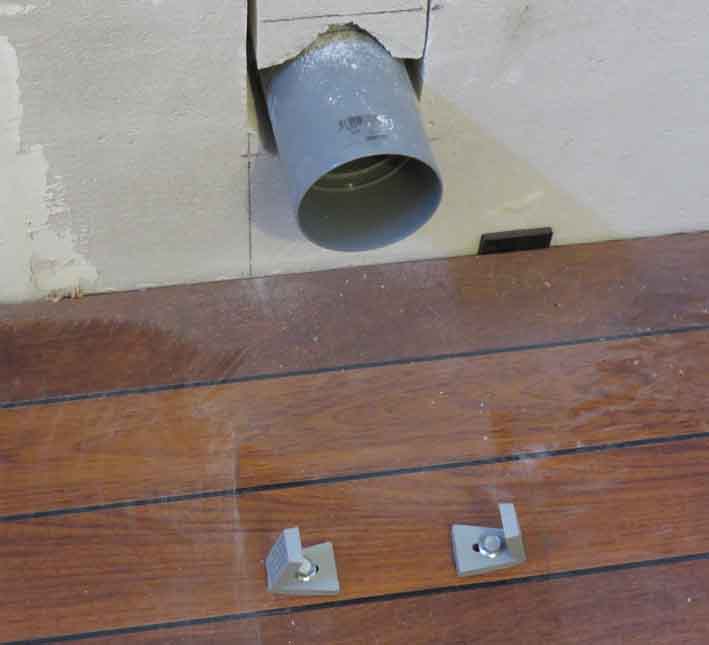
These little floor lugs are new to me and they certainly make fixing a toilet bowl to the floor a whole lot easier.
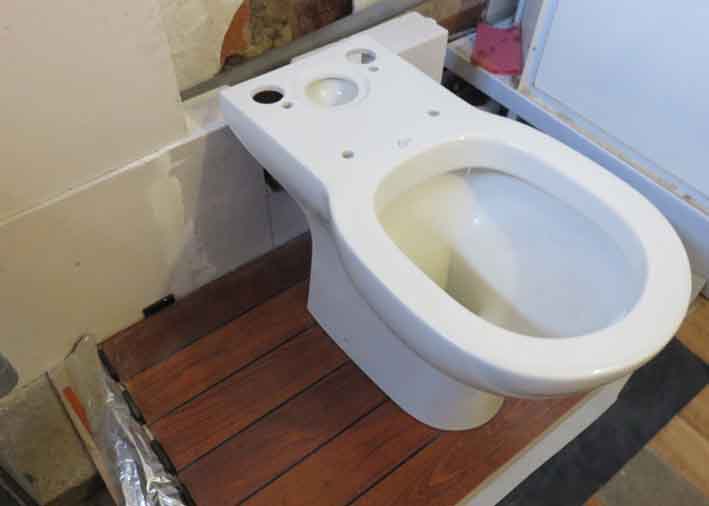
And here is the toilet bowl plumbed into the drain, which runs behind the new wall. You can see that there isn't much room between the new toilet and the back of the old shower, but the old shower will be coming out once the new one is working.
The next task was the longest and most difficult and that was to build a shower from scratch.
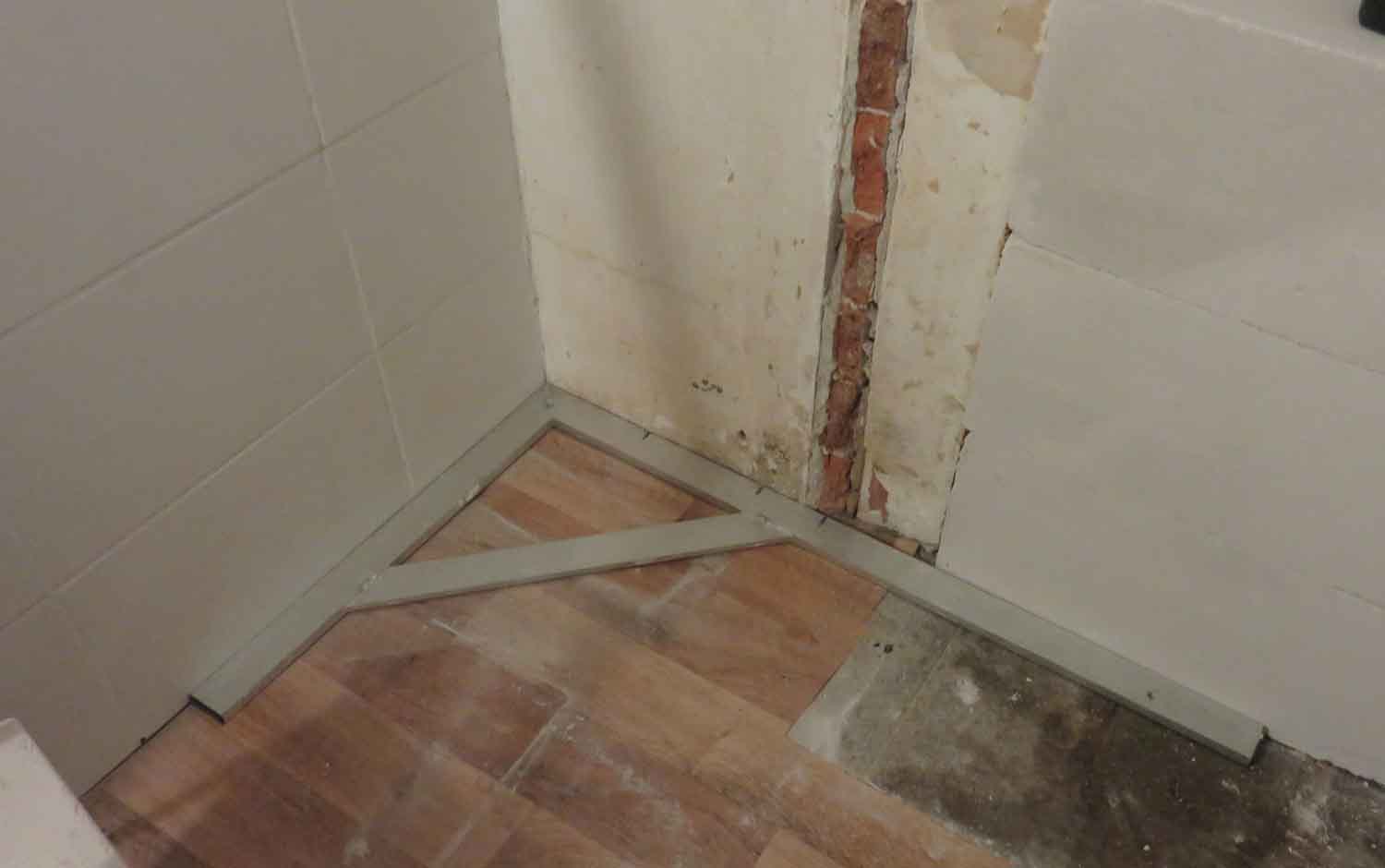
First, the old doorway, where the toilet used to sit, needed blocking up and a new window installed. It is useful to have the biggest builders square possible when lining up new blocks with an existing wall.
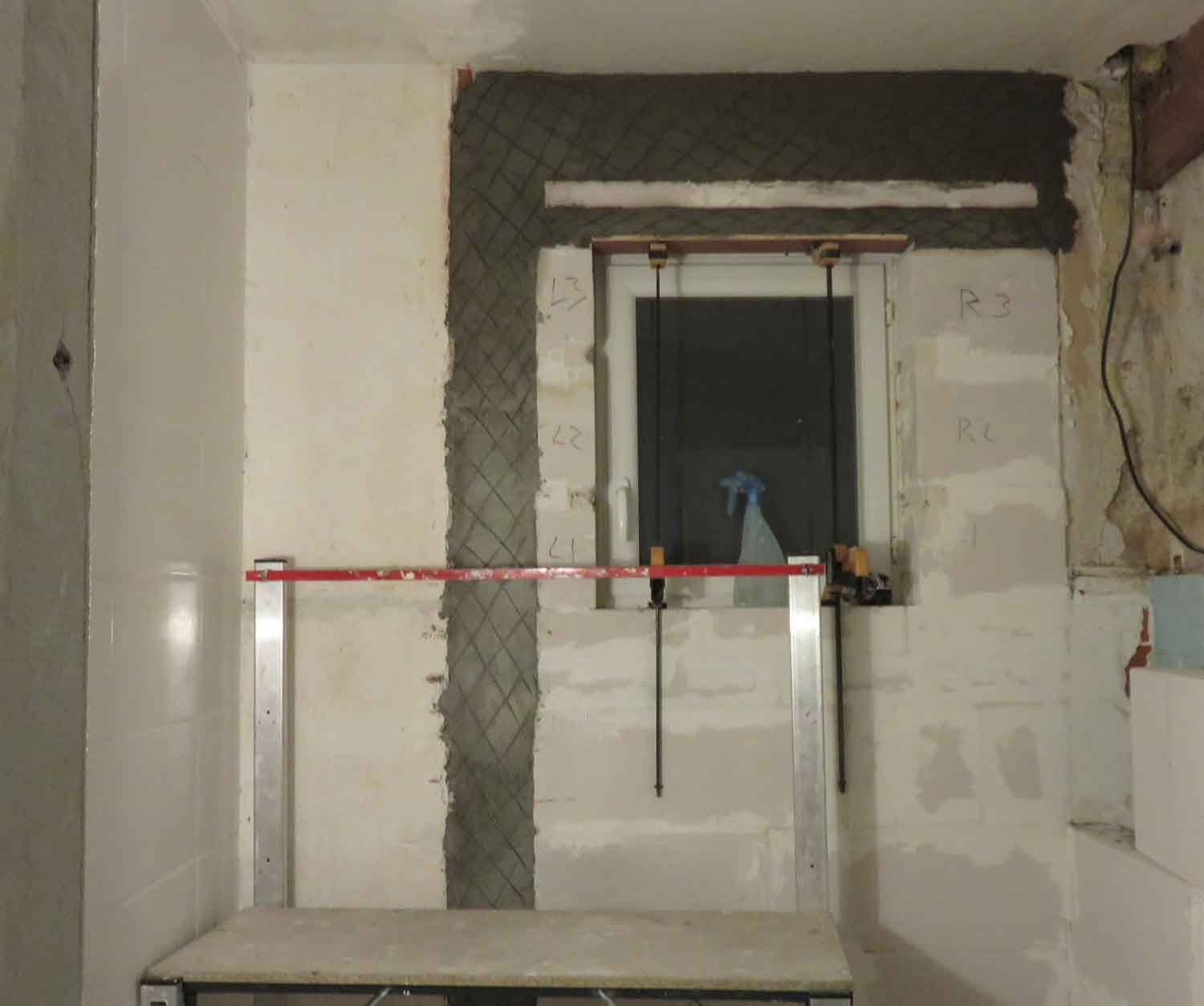
The new window in place and the final wall of the shower going up. Before the tiles are stuck on, the new blocks need a coat of primer. Otherwise they suck all the moisture out of the tile cement before it has cured and the tiles fall off the wall.
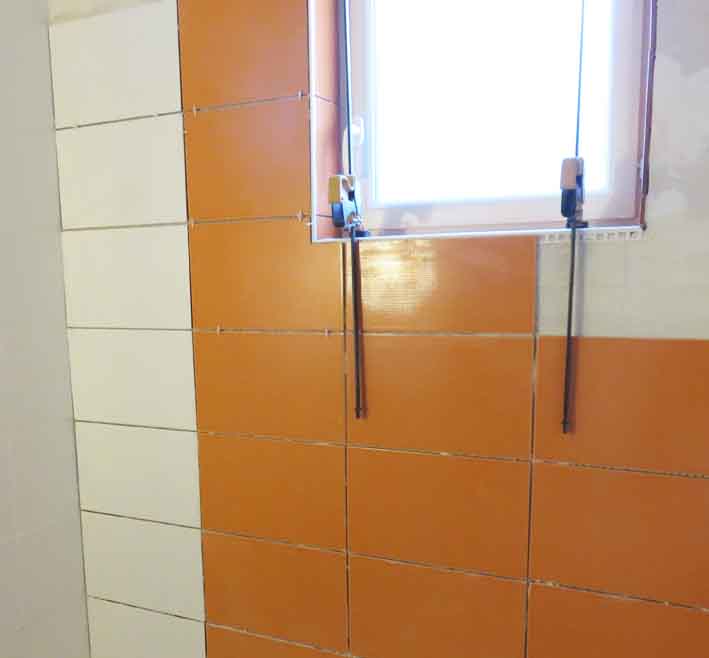
Once the basic structure was built, the drain connected into the fosse and the subtly sloped floor laid, it was time to tile the walls. We had bought the tiles some time ago and had slightly changed the design of the shower since then. I was worried that if I broke a few cutting them, that we might not have quite enough and, needless to say they were now a discontinued line.
My solution was to carry the white tiling on the left hand wall round onto the back wall before starting the orange tiling.
The clamps in the window opening are to stop the tiles in the top of the rebate from falling off before the glue is set.
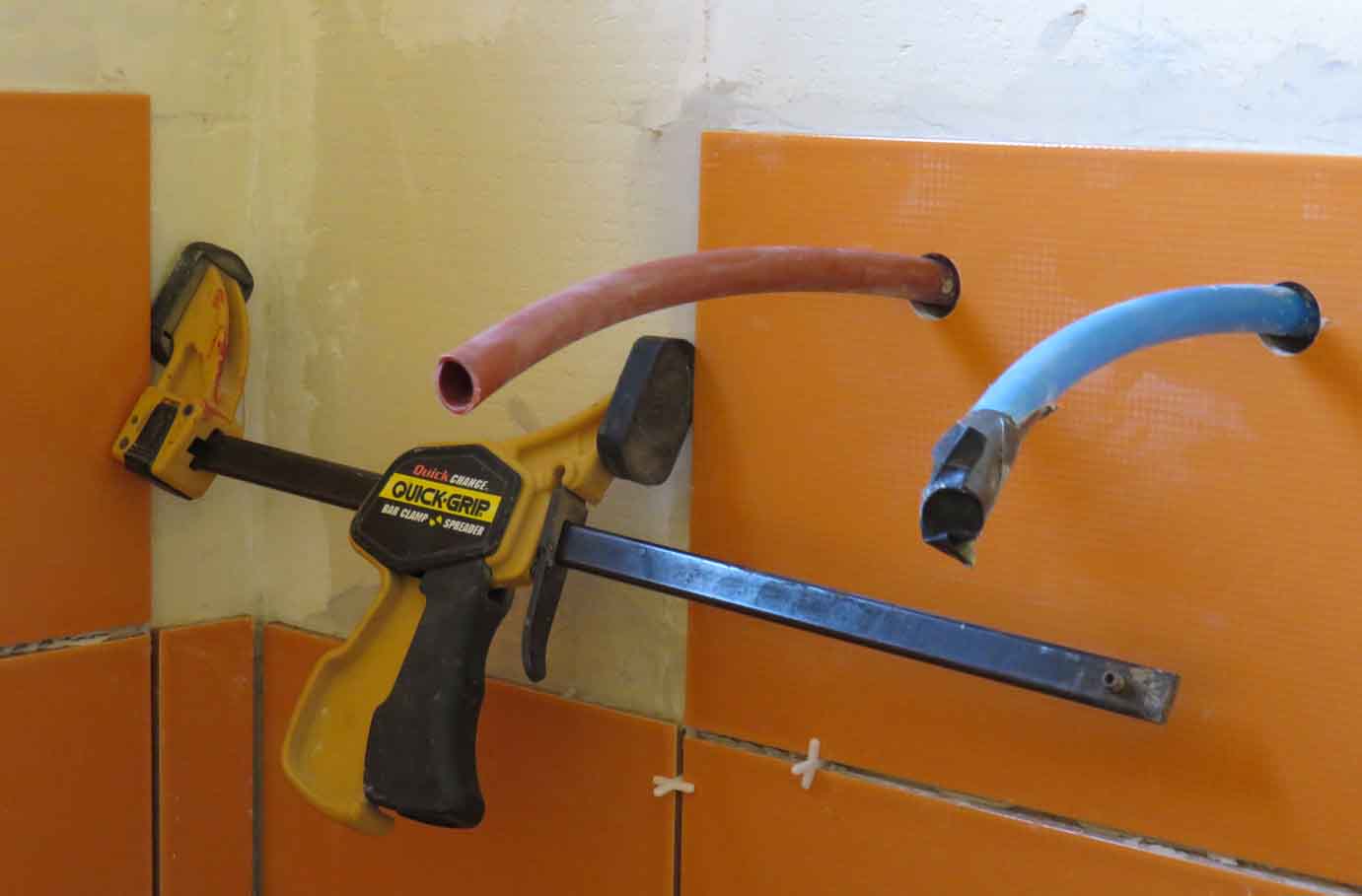
I also used a clamp to gently offset the sideways pressure from the water pipes, which was pushing the tile off line. As the man said, you can never have too many clamps. In fact, that tile had to come off again a few days later and for the first time I felt a little let down by French plumbing fittings, which I usually rave over. In England, when plastic pipes poke through the wall like this, you screw a plate to the tile, which contains a compression fitting to hold the end of the pipe. Our French plumbers had never heard of such a thing. Instead they wanted to use a plate which went under the tile.
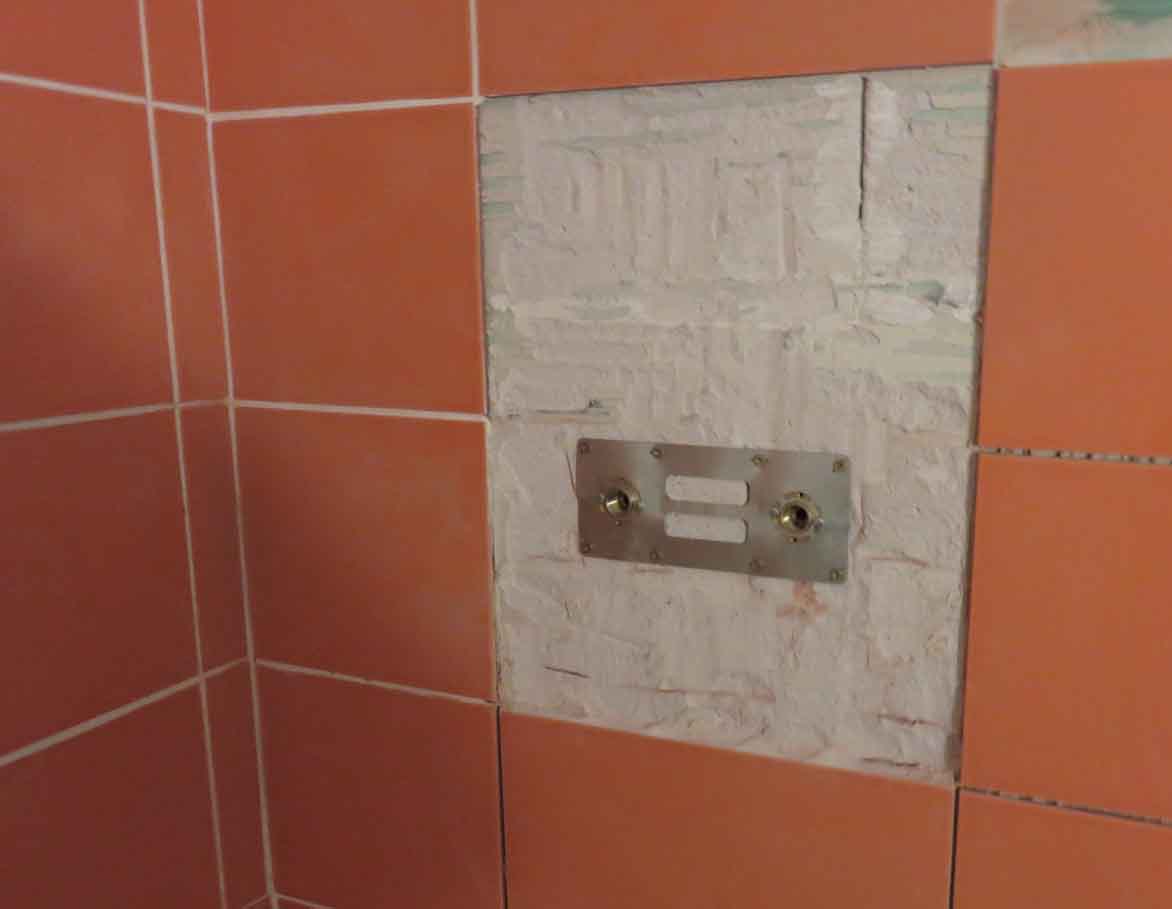
The advantage of this approach is that it guarantees that the pipes are the correct distance apart for a standard shower fitting. However they are only designed for thin walls or for walls that have been gouged out to take the pipes downwards, not for my solid 100mm thick blocks. They got around the problem by modifying some fittings from a completely different application and voila, taps on the wall.
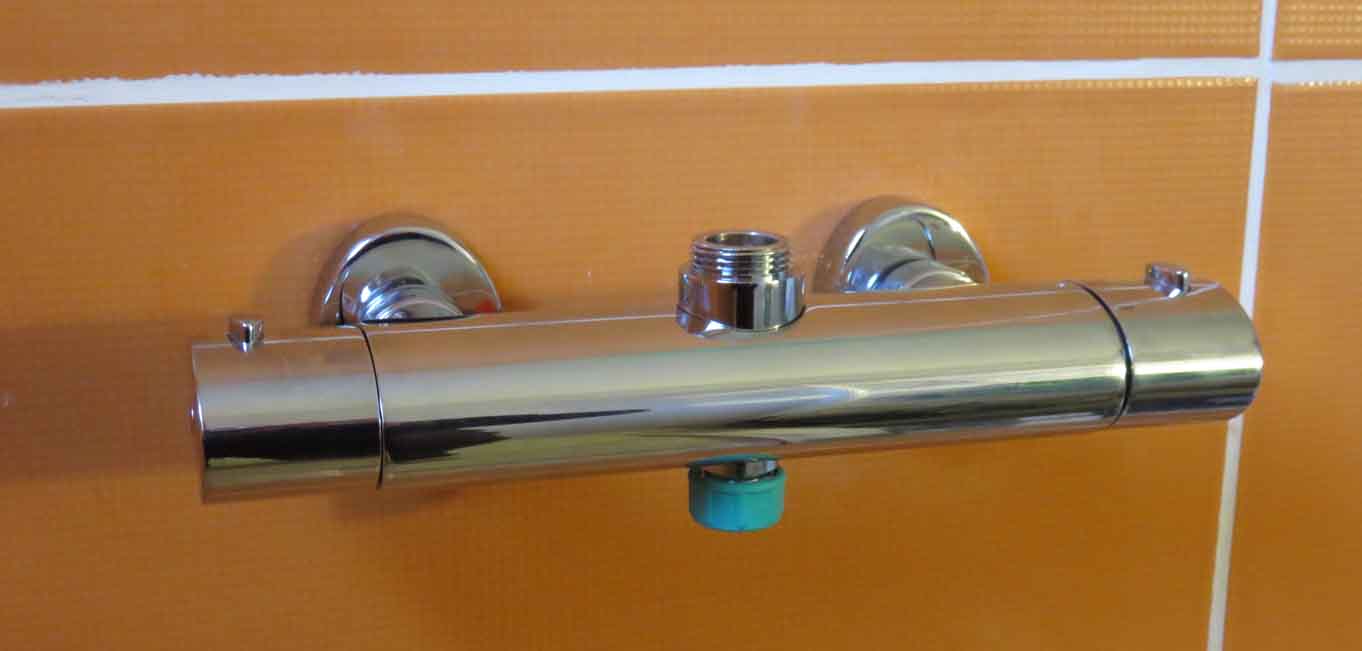
In the next update, I will tell you all about the glass block shower wall and whether it is still standing. There are bets out on this so wait with bated breath.
THE CURSE OF THE ALANS
My name is Alan Pomeroy (I always hear the voice of Michael Caine at this point. You must remember him saying "My name is Harry Palmer" in The Ipcress File) and the Pomeroy family "migrated" to England with William the Conqueror.
My parents did not know that when they named me Alan and they certainly didn't know that Alan was a Breton name that may well have been derived from a band of barbarians that were settled on the borders of Brittany by the Romans to help keep the rebellious Armoricans in order.
When I found out that I was named after a barbarian tribe, everything fell into place. I wasn't a suburban drone, but a mighty nomad warrior, wandering the vast steppes with the shrunken heads of my enemies slung from my saddle. Anyway, I was intrigued enough to want to know more about this barbarian tribe that I had never before heard of. I knew something about the Huns, the Vandals, the Goths, the Alamani and, of course, Asterix the Gaul, but nothing about the Alans. What I did not realize at the time was that I had been struck by what I now call the curse of the Alans.
You know when you dig up a mummy in Egypt, you are almost guaranteed to get some monster chasing you. Well digging into the story of the Alans releases a monster with no solid body, but with tentacles spreading everywhere.
Their name is known in at least nine different languages, including Hebrew and Chinese, yet we know very little about them. They fought for the Romans, the Huns, the Vandals, and the Goths and against the Romans, the Huns, the Vandals and the Goths and in some battles fought for both sides at the same time. Some authors have even linked them to the knights of King Arthur, the Amazons and the birth of Russia, yet we have not more than half a dozen written words of the original Alanic language.
They have left their mark on place names from the Darial pass in the Caucasus (Gate of the Alans in Persian) to Catalonia (Goth-Alania) in Spain, but we have no busts or carvings of their leaders.
There are literally hundreds of references to Alans in historical records. The problem is that that each of them is just a fleeting glance. The Alans appear everywhere, but only as a footnote to historical events, or as part of a list of barbarian tribes that appear for or against the main protagonists of a story.
They appear in history during the first five hundred years of the Common Era, a time when the Roman Empire was breaking up and history was not the organized subject it later became, so the records themselves are sparse and randomly preserved. Many texts were written for a particular political or religious purpose, so even more bias than is usual in historical tracts is evident.
The other important point to make applies not just to the Alans, but to all of the barbarian tribes who appear in history at around the same time. When we talk about Alans, Goths, Vandals or Huns, we do not necessarily mean a coherent group such as modern day French or Russian; think instead of settlers in America in the seventeenth and eighteenth centuries. People with many different languages, cultures and religions: Some born in America, some immigrants, but all calling themselves American.
The loose knit nature of barbarian tribes can be clearly seen in the historical description of battles. There are a number of occasions when Alans and Huns fought on both sides. We find Gothic and Vandal generals in the imperial Roman army. Many individuals passed freely in and out of particular tribes, with the change, before the days of customs posts and National Insurance numbers, occasioning nothing more than a different hairstyle and some new baubles. The whole world was a free movement Schengen area in those days. When Alans, or any other barbarian tribe, are mentioned, it means a group of people, probably containing a majority of the named tribe, unless the early historian has identified the wrong tribe in the first place.
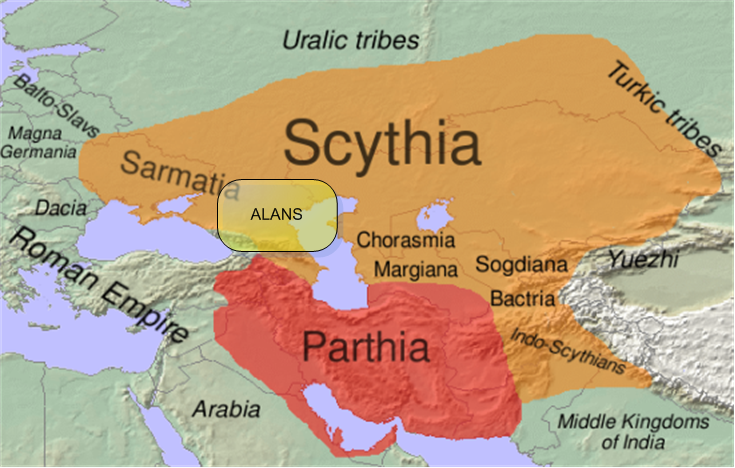
So what have I found out about the Alans so far. Well, they seem to have been part of the Indo-Iranian branch of the Indo-European family to which many of us belong and to have originated to the north of present day Iran, between the Caspian and Aral seas. At the time they appear in history, they are concentrated around the river Don, between the Black and Caspian seas on the edge of the Roman empire and were part of the larger Sarmatian confederation of tribes.
Bear that in mind as I tell you a couple of short tales about Alans.
Chinese excursion
The office of First Parasol Bearer doesn't immediately conjure up the image of a fierce barbarian, prepared to give his life for his king or Emperor , but that was the title given to the Alan warrior Jiao Hua in the court of the Mongol dynasty of Chinese Emperors, so perhaps parasol loses a little in translation. As a result of his military prowess, he also acquired his father's titles of Officer of the Imperial Guard followed by Chiliarch [Battalion commander] of the Left guard, reporting to the Left King. You have to know that the Mongols oriented themselves geographically looking south, so the Left King was the king of the eastern provinces. There was also a Right King and they both reported up to the Emperor.
Jiao Hua finally finished a distinguished career as Chief Minister of the Directorate for the Imperial Accessories. No, don't ask; perhaps he looked after the Emperor's Jimmy Choo raping and pillaging boots.
The important point is that the Mongols who invaded China took with them a band of Alans that became prominent in the ranks of the imperial army and the Emperor's personal bodyguard, during the Mongol dynasty of 13th and 14th centuries.
French brawling
Attila with his Hunnic army and Ostrogoth and Gepid allies invaded Gaul in 451 CE and reached as far west as Aurelianum (Orleans) in the Loire valley. There is a tale by the Gothic historian Jordanes that the Alan king Sangiban, whose realm included Aurelianum, had promised Attila that the city gates would be opened. There are no supporting records and the city gates stayed firmly shut, so Attila started a siege.
When a Roman General Aetius and an allied Gothic king Theoridic arrived with a Roman and Gothic army, Attila, almost in control of the city after a successful breach of the walls, retreated eastwards. The two armies finally met on June 20th (or maybe September 20th depending on whom you read) at Châlons-en-Champagne in north eastern France in a clash variously called battle of the Catalaunian Plains, battle of the Campus Mauriacus and battle of Châlons.
Aetius and Theoridic placed the Alans in the centre of their line, with Roman forces on the left flank and Theoridic's Visigoths facing the Ostrogoths on the right flank. The original story was that Aetius was not sure of the loyalty of Sangiban to the cause and thus corralled the Alans between himself and Theoridic, but this does not make a lot of sense. Why pit the Alans directly against the fearsome Huns if they were likely to defect to them. A more modern interpretation is that the Alan cavalry were better suited tactically to face the Huns.
The Huns and the Alans crashed into each other in the centre, whilst Aetius drove back the Gepids and other Germanic tribes. But the decisive move was made by Theoridic who raced ahead of the Alans, scattering the Ostrogoths and threatening Attila's rear. Sometime during this phase of the battle Theoridic was killed, but his maneuver put an end to the Huns will to fight and they withdrew to their camp, probably with the intention of making a famous last stand as they had heaped their saddles in the centre of the camp, ready to create a pyre.
The next morning however, the Visigoths went home to sort out the succession to Theoridic and Attila packed up his souvenir loot and headed home also, leaving Aetius in charge of the field.
Historians to this day argue whether the battle of Châlons was one of the most important struggles in history or a bloody but unimportant skirmish. From our perspective the most important outcome was that Aetius confirmed Sangiban's Alans as having dominion over the middle Loire valley. It is important because about sixty kilometres north of the Loire valley is the tiny village of La Pomeraye, from where the Pomeroy family originated. It's a small world. Back to the Alans.
Alans everywhere
So an insignificant group of barbarians appear in both in China and western France, seven thousand miles and a thousand years apart. But that is not all. Another group travelled with the Goths when they invaded Spain and settled both in Catalonia, which is in northeast Spain and in Portugal. When the Vandals pushed into Spain from France, a group of Goths and Alans migrated to North Africa, settling in parts of what is now Algeria and Tunisia.
Alans were in Europe, Asia and Africa, but sadly there is no trace of them left. Except in one tiny country.
The last of the Alans
In 1994, the name "Alania" was officially added to the title of North Ossetia, making it the Republic of North Ossetia-Alania. In doing so, the Ossetians were restoring links with the medieval kingdom of the Alans, from whom they were descended. You may be forgiven for not knowing this fact, or indeed of never having heard of Ossetia, North or South. North Ossetia is a postage stamp sized Russian republic - some 8000 square kilometers - located in the northern Caucasus.
Its recent history is dominated by the horrifying Beslan school siege in 2004; when 334 civilians, including 186 children, were killed in a gun battle between Chechen separatists and Russian security forces at School Number One in the Ossetian town of Beslan.
South Ossetia is a Georgian state that is even smaller than its northern cousin, about a third of a postage stamp. South Ossetia also made the news in the early part of the twenty first century and for equally tragic reasons. It declared independence from Georgia and in August 2008, Georgia and Russia fought over it. For the West, it was the big bad Russians oppressing the small freedom loving Georgians. For the Russians, it was the big bad Georgians oppressing the small freedom loving Ossetians. The Ossetians discovered that in the twenty first century they can choose between being ruled by Russia or being ruled by Georgia, ruling themselves is not an option.
It is unsurprising that turmoil and tragedy dog the lives of the peoples of these tiny territories; they sit on one of the fault lines of civilization. Wedged between the Black and Caspian seas, the Caucasus is a natural barrier between the plains of the Near East and the Russian and Ukrainian steppes. There are few gaps in the mountain range and anyone sitting in those gaps controls all North - South movement. Here is where populations and religions have rubbed up against each other for at least the last 4000 years.
The Ossetians are the largest extant group of people who claim the barbarian race of Alans as their ancestors. They speak an Indo-Iranian language and call themselves Iron, which is nothing to do with the metal, but instead derives from an Iranian dialectical form of Aryan. You can see how the remaining Alans that hadn't gone West or East would have been pushed away from the Don river and further into the mountain fastness of the Caucasus when later groups of barbarians moved across the steppes.
I first promised to publish something about the Alans back in September, 2009, but the curse of the Alans prevents me from keeping that promise. Every time I think I have nailed down their story, some new source pops up which either contradicts what I thought I knew or takes me to some completely different corner of the world and those are just the archaeological and historical sources. A new dimension of the curse has now raised its head and that is genetic analysis. This used to be expensive and fairly inaccurate, but is now cheap and pretty accurate and the problems of contamination of ancient DNA , whilst not completely solved, can now be kept within manageable limits.
Some Russian linguists are now using DNA analysis results to back up their claim that Ossetians are not descended from Alans (they would much prefer them to be descended from Russians). However, there do seem to be differences between maternal lines of descent and paternal lines of descent in the Ossetian population.
What it means for me is that I have to learn enough about genetics to at least make an educated guess as to whether Vlad Putin's henchmen have a case. It also means that I need to trawl for any genetic analysis done in any other areas where Alans have been spotted.
I am no nearer publishing my definitive work on the Alans, not that there is such a thing as a definitive work on a group of people so lost in history and I now understand that I will never complete it in my lifetime, but the journey is always more interesting than the destination, so I will enjoy plugging away at it.
Wouldn't it be funny if the Pomeroys, who were in the right area for one of the groups of Alans, were genetically near related to them. I would be an Alan twice over.